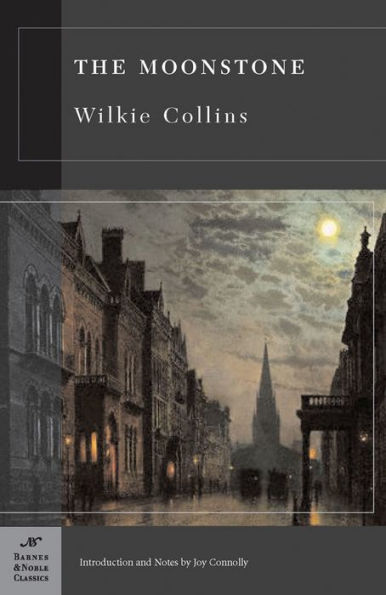Read an Excerpt
From Joy Connolly’s Introduction to The Moonstone
“King of inventors” was the title given to Wilkie Collins at the height of his powers, and popular opinion has since ranked The Moonstone (1868), rivaled only by The Woman in White (1859–1860), as Collins’s greatest masterpiece of invention. Mystery buffs know it as the first detective novel in English; fans of nineteenth-century literature prize its blend of sensational thrill, social criticism, and romance. Set by turns in the country comfort of Victorian squiredom, London townhouses, seashore lodgings, and in exotic landscape of India, the novel retains the page-turning suspensefulness that captivated its first generation of readers. “A very curious story,” wrote Charles Dickens, Collins’s close friend and mentor, “wild, and yet domestic—with excellent character in it, great mystery. . . . It is prepared with extraordinary care, and has every chance of being a hit” (Letters of Charles Dickens, vol. 3, p. 660; see “For Further Reading”).
A hit it certainly was. The story first appeared in 1868 as a thirty-two part serial, beginning on January 1 and ending August 8, in Dickens’s weekly magazine All the Year Round. In the summer, as the final segments unveiled the solution to the mystery of the theft of the Verinder family’s Indian heirloom, avid readers packed the streets outside the magazine’s offices in the hope of securing copies, and bets were placed on the outcome of the plot. Sales records of the magazine, as well as the hardbound edition, and the popularity of the stage play that quickly followed, suggest that fans were not disappointed. An appreciative reviewer for the London Times declared Collins an unrivaled master in the business of sensational novel-writing. Geraldine Jewsbury, a well-respected critic and also a friend of Dickens, praised Collins’s achievement in stronger terms. Her admiration for his sympathetic portrayal of characters on the margins of society, especially women, the poor, and people of color, in part anticipates the novel’s appeal to the diverse readership of the present day. As for Dickens, whether from an honest change of heart or sheer jealousy (The Moonstone outsold Great Expectations), he ultimately dismissed the book, complaining sourly in a private letter that its construction was “wearisome beyond endurance.”
Today, as then, Dickens is contradicted by a host of admiring readers. Unfolding in twelve separate voices in fourteen blocks of narrative during which the great yellow diamond of the title is stolen no less than four times, the novel’s construction is an extraordinary feat. The expertly timed switch from voice to voice (a favorite novelistic device of Collins) gives a democratic, upstairs-downstairs feel to the book. Collins’s sensitivity to social injustice, a lifelong theme of his work, makes itself felt in the contrasting perspectives of the intensely sympathetic, tormented Doctor Ezra Jennings, and the cheerfully self-absorbed Franklin Blake. Blake is the cousin and suitor of Rachel Verinder, heir to the stolen Moonstone, and it is he who collects the narratives more than two years after the diamond’s theft, “in the interests of truth, to be placed on record in writing”—a fictional echo of Collins’s own habitual protestations that his novels were based on real events and careful research.
Staking claim to authenticity is a staple of Collins’s professional specialty, the Victorian subgenre of sensational fiction—denounced by high-minded clergymen and critics as a corrupting influence on public morals, and embraced by the British middle class for its racy pleasures. Sensational fiction was part of the historic explosion in mass culture that emerged in its modern form in the Victorian era. Industrialization and urbanization, the double-edged achievements of mid-nineteenth-century Europe and America, were opening up unprecedented stretches of leisure time that could be whiled away in zoos, public gardens, Turkish baths, music halls, amateur sports, charity work, literary societies, lectures on everything from magnetism to the causes of poverty, and reading. Novels like Mary Elizabeth Braddon’s Lady Audley’s Secret and Ellen Wood’s St. Martin’s Eve terrified and entertained readers with the tragic undersides of this modern society—especially the workhouse, brothel, and lunatic asylum—and with the hidden crimes of domestic life, from abuse and illegitimacy to suicide and murder.
More often than not, these tales are moralistic in the simplest sense, making the bad end badly and the good end well, and though the bad occasionally escape the reach of human law, the authors make it clear that they will not escape God’s. If they strike modern tastes as more exploitative than improving, it’s worth recalling that sensational tales helped make everyday human suffering a central concern of British popular culture. Unlike their modern counterparts in the televised melodrama or pulp novel, many of them back real and realizable goals of social reform. Collins’s The Woman in White is often said to lead the genre, with its chilling portrayal of the prison-like terrors of the madhouse and the desolation of unmarried mothers and illegitimate children. The Moonstone, though it owes much to sensational literature and was certainly marketed as such, is more difficult to classify. Readers tend to hail it instead as anticipating a new mode of writing, as T. S. Eliot did when he called The Moonstone “the first, longest, and greatest” of all English detective novels—a sentiment echoed by mystery writers Dorothy Sayers, P. D. James, and many others since.




